 | | | Switch to: Europe, USA, New Zealand, Antarctica Credit: NOAA/Ovation  Planetary K-index Planetary K-index
Now: Kp= 0.67 quiet
24-hr max: Kp= 3.00 quiet
explanation | more data
Interplanetary Mag. Field
Btotal: 3.87 nT
Bz: 2.46 nT north
more data: ACE, DSCOVR
Updated: Today at 1146 UT  Coronal Holes: 04 Feb 23 Coronal Holes: 04 Feb 23 
There are no significant coronal holes on the Earthside of the sun. Credit: SDO/AIA  Noctilucent Clouds Noctilucent Clouds
The southern hemisphere season for noctilucent clouds has begun. NASA's AIM spacecraft detected the first electric-blue puffs over Antarctica on Dec. 1st. Switch view:Ross Ice Shelf, Antarctic Peninsula, East Antarctica, Polar Updated Feb04  SPACE WEATHER
NOAA Forecasts | | Updated at: 2023 Feb 04 2200 UTC FLARE | 0-24 hr | 24-48 hr | CLASS M | 05 % | 05 % | CLASS X | 01 % | 01 % |  Geomagnetic Storms: Geomagnetic Storms:
Probabilities for significant disturbances in Earth's magnetic field are given for three activity levels: active, minor storm, severe storm Updated at: 2023 Feb 04 2200 UTC Mid-latitudes | 0-24 hr | 24-48 hr | ACTIVE | 10 % | 20 % | MINOR | 01 % | 05 % | SEVERE | 01 % | 01 % | High latitudes | 0-24 hr | 24-48 hr | ACTIVE | 15 % | 15 % | MINOR | 20 % | 25 % | SEVERE | 10 % | 25 % | | | |  | | | | | | | | | | | Never miss another geomagnetic storm. Sign up for Space Weather Alerts and you'll receive a text message when magnetic storms erupt. Aurora tour guides and professional astronomers use this service. You can, too! | | | QUIET WITH A CHANCE OF FLARES: This weekend, solar activity is low. However, there is an increasing chance of C-class flares as new sunspots AR3206 and AR3207 continue to grow. Solar flare alerts: SMS Text. WHAT'S OVER THE HORIZON? Yesterday, a dense, hot plume of plasma jumped up from behind the sun's northeastern limb. Click to set the scene in motion: 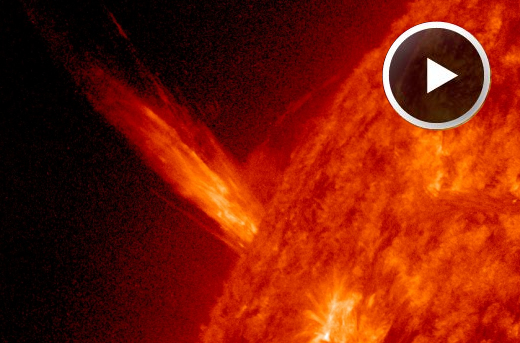
The eruption suggests that an active sunspot may be hiding just over the horizon. If so, it should show itself by Monday or Tuesday, turned toward Earth by the sun's 27-day rotation. An emerging sunspot would boost the chance of flares next week. Solar flare alerts: SMS Text. Realtime Space Weather Photo Gallery
Free: Spaceweather.com Newsletter A COMET VERY CLOSE TO THE SUN: On Jan. 31st, Comet 96P/Machholz swung by the sun deep inside the orbit of Mercury and briefly became one of the brightest comets in years. Most astronomers didn't bother observing because of the glare. Award winning astrophotographer Nicolas Lefaudeux, however, decided to give it a try, and this is what he saw: 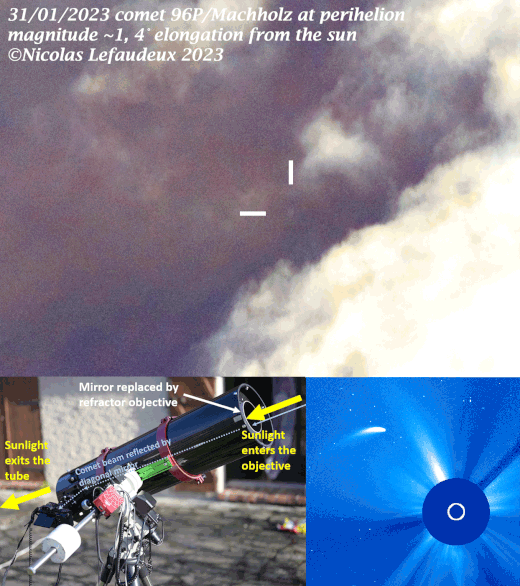
"I captured Comet 96P/Machholz only 4 degrees from the sun!" says Lefaudeux. Lefaudeux has done this kind of thing before. His images of Venus close to the sun are well known, and his techniques for eliminating solar glare have been honed over the years . "This time I used a Newtonian telescope tube, on which I replaced the primary mirror by a refractor objective," explains Lefaudeux. "In this 'reversed' configuration the beam of the comet gets reflected to the camera, while the dangerous sun beam exits the tube. Conditions were far from ideal, with only partial cloud break in front of the low altitude winter sun. Yet, it proves that sungrazing comets can be imaged from the ground by amateurs using simple means!" more images: from José Maria Oncins Lagranja of Zaragoza, España Realtime Space Weather Photo Gallery
Free: Spaceweather.com Newsletter VALENTINE'S CRYSTAL BEAR AND ROSE: Valentine's Day is coming. Looking for a far-out gift? This Crystal Bear and Rose flew to the stratosphere onboard a cosmic ray research balloon on Dec. 17th:
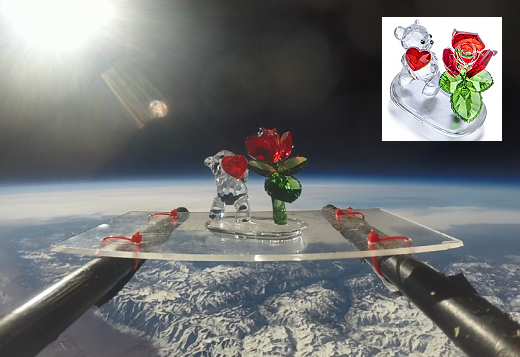
You can have it for $129.95. The students of Earth to Sky Calculus are selling space bears to support their high-altitude ballooning program. Each one comes with a greeting card showing the ursine astronaut in flight and telling the story of its journey to the edge of space and back again. Far Out Gifts: Earth to Sky Store
All sales support hands-on STEM education
Realtime Aurora Photo Gallery
Free: Spaceweather.com Newsletter Every night, a network of NASA all-sky cameras scans the skies above the United States for meteoritic fireballs. Automated software maintained by NASA's Meteoroid Environment Office calculates their orbits, velocity, penetration depth in Earth's atmosphere and many other characteristics. Daily results are presented here on Spaceweather.com. On Feb 03 2023, the network reported 4 fireballs.
(4 sporadics) 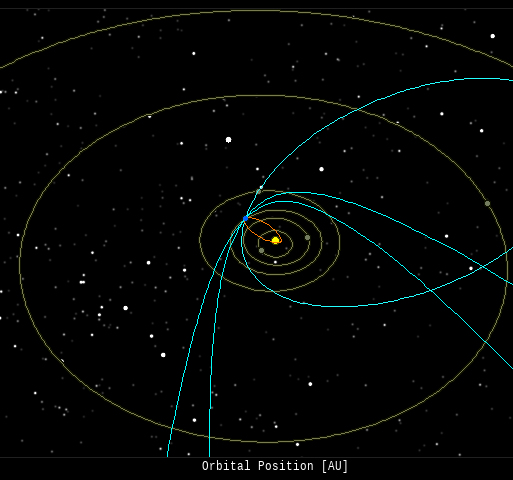 In this diagram of the inner solar system, all of the fireball orbits intersect at a single point--Earth. The orbits are color-coded by velocity, from slow (red) to fast (blue). [Larger image] [movies] Potentially Hazardous Asteroids ( PHAs) are space rocks larger than approximately 100m that can come closer to Earth than 0.05 AU. None of the known PHAs is on a collision course with our planet, although astronomers are finding new ones all the time. On February 4, 2023 there were 2328 potentially hazardous asteroids.
 | Recent & Upcoming Earth-asteroid encounters: | Asteroid | Date(UT) | Miss Distance | Velocity (km/s) | Diameter (m) | | 2023 BV5 | 2023-Jan-30 | 6.6 LD | 3.2 | 10 | | 2023 CK | 2023-Jan-30 | 0.3 LD | 9.6 | 14 | | 2023 BJ7 | 2023-Jan-30 | 1 LD | 8 | 6 | | 2023 CA | 2023-Jan-30 | 1.7 LD | 12.6 | 21 | | 2023 BA3 | 2023-Jan-30 | 3.4 LD | 8.8 | 19 | | 2023 CE | 2023-Jan-30 | 12.9 LD | 16.6 | 26 | | 2023 AS1 | 2023-Jan-31 | 11.8 LD | 6.2 | 24 | | 2023 BA4 | 2023-Jan-31 | 17.7 LD | 7.9 | 40 | | 2023 BQ2 | 2023-Jan-31 | 5.7 LD | 13.9 | 17 | | 2023 BP6 | 2023-Feb-01 | 6.8 LD | 9.7 | 59 | | 2023 CB | 2023-Feb-01 | 15.9 LD | 7.8 | 21 | | 2017 DU34 | 2023-Feb-02 | 13.3 LD | 11.2 | 16 | | 2023 BY4 | 2023-Feb-02 | 12.9 LD | 10.8 | 41 | | 2023 BP5 | 2023-Feb-02 | 4.4 LD | 6.3 | 14 | | 2023 BB8 | 2023-Feb-02 | 15.6 LD | 11.2 | 30 | | 2023 BH6 | 2023-Feb-02 | 5.8 LD | 9.7 | 8 | | 2023 BX7 | 2023-Feb-02 | 4.2 LD | 13.5 | 34 | | 2023 BR5 | 2023-Feb-03 | 10.9 LD | 7.9 | 11 | | 367789 | 2023-Feb-03 | 4.7 LD | 9.9 | 149 | | 2023 BN6 | 2023-Feb-04 | 2 LD | 7.5 | 31 | | 2020 OO1 | 2023-Feb-04 | 4.8 LD | 7.7 | 19 | | 2023 BO7 | 2023-Feb-04 | 14.3 LD | 5.1 | 13 | | 2023 BZ7 | 2023-Feb-04 | 12.1 LD | 9.3 | 22 | | 2023 BC4 | 2023-Feb-04 | 16.2 LD | 11.6 | 53 | | 2023 BG4 | 2023-Feb-05 | 17.2 LD | 10.4 | 32 | | 2023 BT1 | 2023-Feb-06 | 16.9 LD | 8.8 | 30 | | 2023 CC | 2023-Feb-06 | 3.9 LD | 9 | 22 | | 2022 YO6 | 2023-Feb-06 | 12.1 LD | 13.4 | 163 | | 2023 BU7 | 2023-Feb-08 | 1.3 LD | 1.7 | 3 | | 2023 BS | 2023-Feb-08 | 19.4 LD | 10.9 | 35 | | 2023 BO8 | 2023-Feb-08 | 4.2 LD | 6.6 | 15 | | 2022 CX1 | 2023-Feb-09 | 17.4 LD | 13.2 | 14 | | 2023 BC8 | 2023-Feb-11 | 15.4 LD | 14 | 53 | | 2021 EP4 | 2023-Feb-13 | 19 LD | 6.1 | 5 | | 199145 | 2023-Feb-16 | 12 LD | 24.6 | 756 | | 2022 RG | 2023-Feb-16 | 8.2 LD | 3 | 24 | | 2020 DG4 | 2023-Feb-17 | 1.4 LD | 6.9 | 8 | | 2020 CX1 | 2023-Feb-19 | 17.4 LD | 7.7 | 53 | | 37638 | 2023-Feb-21 | 17 LD | 11.1 | 495 | | 2023 AA2 | 2023-Feb-22 | 17.4 LD | 10.1 | 133 | | 2012 DK31 | 2023-Feb-27 | 12.6 LD | 15.5 | 148 | | 2006 BE55 | 2023-Feb-28 | 9.4 LD | 13.3 | 148 | | 2021 QW | 2023-Mar-03 | 13.9 LD | 12.1 | 79 | | 2017 BM123 | 2023-Mar-03 | 12.1 LD | 7.8 | 62 | | 2007 ED125 | 2023-Mar-03 | 11.7 LD | 13.1 | 224 | | 2015 EG | 2023-Mar-04 | 13.9 LD | 10.6 | 27 | | 2023 BK5 | 2023-Mar-05 | 17.9 LD | 8.5 | 59 | | 535844 | 2023-Mar-07 | 10.5 LD | 7.7 | 150 | | 2020 FQ | 2023-Mar-09 | 14 LD | 6.3 | 13 | | 2020 FV4 | 2023-Mar-13 | 17.6 LD | 8.2 | 30 | | 2023 CM | 2023-Mar-15 | 10.6 LD | 13.8 | 196 | | 2018 UQ1 | 2023-Mar-17 | 10.7 LD | 11.7 | 143 | | 2016 WH | 2023-Mar-19 | 18.1 LD | 11.8 | 14 | | 2018 FE3 | 2023-Mar-21 | 10.1 LD | 5.4 | 13 | | 2022 YK4 | 2023-Mar-29 | 11.9 LD | 2.3 | 25 | | 2017 SE12 | 2023-Mar-30 | 5.2 LD | 8.4 | 15 | | 2016 GH1 | 2023-Mar-30 | 7.7 LD | 5.8 | 11 | | 2022 GO3 | 2023-Apr-02 | 17 LD | 11.6 | 15 | | 2021 GN1 | 2023-Apr-02 | 17.7 LD | 14.2 | 18 | Notes: LD means "Lunar Distance." 1 LD = 384,401 km, the distance between Earth and the Moon. 1 LD also equals 0.00256 AU. | | Cosmic Rays in the Atmosphere | SPACE WEATHER BALLOON DATA: Almost once a week, Spaceweather.com and the students of Earth to Sky Calculus fly space weather balloons to the stratosphere over California. These balloons are equipped with sensors that detect secondary cosmic rays, a form of radiation from space that can penetrate all the way down to Earth's surface. Our monitoring program has been underway without interruption for 7 years, resulting in a unique dataset of in situ atmospheric measurements. Latest results (July 2022): Atmospheric radiation is decreasing in 2022. Our latest measurements in July 2022 registered a 6-year low: 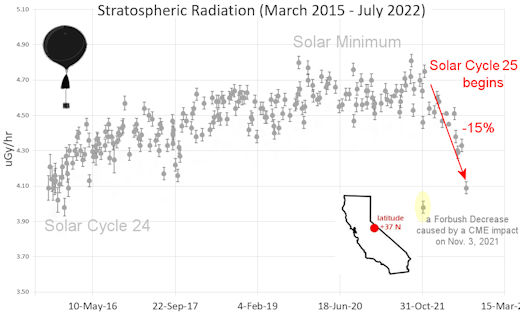
What's going on? Ironically, the radiation drop is caused by increasing solar activity. Solar Cycle 25 has roared to life faster than forecasters expected. The sun's strengthening and increasingly tangled magnetic field repels cosmic rays from deep space. In addition, solar coronal mass ejections (CMEs) sweep aside cosmic rays, causing sharp reductions called "Forbush Decreases." The two effects blend together to bring daily radiation levels down. .Who cares? Cosmic rays are a surprisingly "down to Earth" form of space weather. They can alter the chemistry of the atmosphere, trigger lightning, and penetrate commercial airplanes. According to a study from the Harvard T.H. Chan school of public health, crews of aircraft have higher rates of cancer than the general population. The researchers listed cosmic rays, irregular sleep habits, and chemical contaminants as leading risk factors. A number of controversial studies (#1, #2, #3, #4) go even further, linking cosmic rays with cardiac arrhythmias and sudden cardiac death. Technical notes: The radiation sensors onboard our helium balloons detect X-rays and gamma-rays in the energy range 10 keV to 20 MeV. These energies span the range of medical X-ray machines and airport security scanners. Data points in the graph labeled "Stratospheric Radiation" correspond to the peak of the Regener-Pfotzer maximum, which lies about 67,000 feet above central California. When cosmic rays crash into Earth's atmosphere, they produce a spray of secondary particles that is most intense at the entrance to the stratosphere. Physicists Eric Regener and Georg Pfotzer discovered the maximum using balloons in the 1930s and it is what we are measuring today. | | The official U.S. government space weather bureau | | | The first place to look for information about sundogs, pillars, rainbows and related phenomena. | | | Researchers call it a "Hubble for the sun." SDO is the most advanced solar observatory ever. | | | 3D views of the sun from NASA's Solar and Terrestrial Relations Observatory | | | Realtime and archival images of the Sun from SOHO. | | | information about sunspots based on the latest NOAA/USAF Active Region Summary | | | current counts of failed and deployed Starlink satellites from Jonathan's Space Page | | | Authoritative predictions of space junk and satellite re-entries | | | from the NOAA Space Environment Center | | | fun to read, but should be taken with a grain of salt! Forecasts looking ahead more than a few days are often wrong. | | | from the NOAA Space Environment Center | | | the underlying science of space weather |  | BestCSGOGambling is the best site for everything related to CSGO gambling on the web |  | To find reviews of new online casino sites in the UK try The Casino DB where there are hundreds of online casino reviews complete with bonuses and ratings. Alternatively, Online-Casinos.xyz is another massive directory of online casinos listing sites for the UK and Worldwide. Casinos that offer Rupees for bonuses are very generous to Indian players. Find the best online casinos in India at AllCasinos.in Looking for a new online casino? Try Casimpo the new site dedicated to making online casino simple, or check out the new Avenger Slots Casino and Ace Online Casino with over 500 online slots and casino games. |  | When looking for casinos to play online when the weather is bad, you can try casino online trucchi for Italian games. If you are not from Finland you can try the Swedish page Svenska casino online to find suitable games, check out svenskacasinoonline.net. Always check your local laws before playing with real money. |  | Looking for sports betting companies not registered on GamStop? CasinoGap has presented a list of sites not on GamStop available for UK players. Check and bet online! Would you like to bet at sites not using GamStop? Look at a list of NonStopCasino sites for online betting that aren't on GamStop. Top-rated bookmakers ever! | | | These links help Spaceweather.com stay online. Thank you to our supporters! | | | | | | | | |  | |  |   | ©2021 Spaceweather.com. All rights reserved. This site is penned daily by Dr. Tony Phillips. | |

